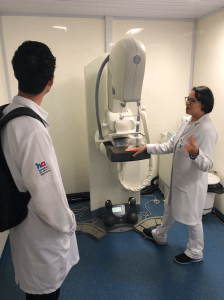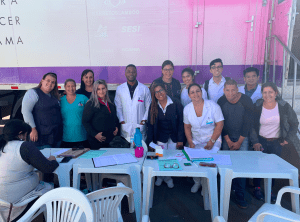Since I began touring and working at Hospital de Amor, I’ve been impressed by the organization’s complete dedication to patient well-being. From colorful waiting rooms (complete with movie theaters, toys, and clowns) for patients at the children’s hospital to mobile clinics shuttling across the 18 neighboring regions to reach patients in rural areas (free of charge), it’s clear that Hospital de Amor’s commitment to patient care is unwavering and humanistic in nature.
Mobile Clinics 101
Mobile clinics play a significant role in the hospital’s goal of democratizing healthcare. These mobile units have proven to be an effective tool in reaching hundreds of patients in some of the most rural towns in the surrounding area. They come in four main varieties: dental, female health, domiciliary, and imaging (equipped with a CT scan). The dental and domiciliary mobile units come in the form of a small fan while those dedicated to female health and imaging are much larger trailers. The smaller vans which contain treatment chairs and minimal storage. The trailers come equipped with a waiting area, 2-4 consultation rooms (each with a patient chair, sink with running water, and storage cabinets), and 2 rooms dedicated for imaging (either CT scans or x-rays). Each of the mobile clinics are on a tight schedule bouncing from town to town everyday of the week in order to maximize patient outreach.
Once they arrive at their destination, the mobile units set up just outside of a local public hospital. Hospital de Amor has partnered with public hospitals in the surrounding regions in order to reach more patients and establish community ties. While the moving clinics and some of the medical staff come from Hospital de Amor, each of the smaller, public hospitals have staff who contribute to the mobile units by helping with patient check in’s, booking appointments, and calling patients to remind them of upcoming consultations.
The medical vans and trailers grant smaller hospitals and, more importantly, their patients access to advanced (and expensive) technologies and treatment that local health facilities cannot offer. Safe to say, when the clinics come to town it’s a HUGE deal. As such, much planning must be done ahead of time. The trajectory of each type of mobile unit is determined about 6 weeks in advance by Hospital de Amor. Once decided, the targeted local hospitals are notified and are given paper schedule templates to fill out with patient names. In order to fill out these long schedule templates, nurses at the local hospitals track down any and all patients and help them determine an appointment time. This process, as I will discuss later, is not only time consuming but does not always translate to 100% patient showout.
Mobile clinics are not super common in the United States so I really wanted to learn more about their innerworkings. Thankfully, my questions were all answered last week as we were lucky enough to visit one of the female health trailers.
Severínia, SP, BR
On Friday morning, Nurse Elaine, Matthew, Diego, and I hopped into a small van and headed towards Severínia. We drove about an hour southwest through rolling hills of sugarcane which seemed to stretch for miles and miles. Before I knew it, we had arrived at the trailer.
Although there are a couple of types of mobile clinics, they are all similar in the meticulous planning and organization that goes into making them run so seamlessly. The clinics operate like well oiled machines thanks to the nurses and volunteers. Nurse Elaine is one of the two nurses in charge of traveling to the trailers and mobile clinics scattered around the regions to conduct quality controls and make sure that things continue to run smoothly. Her job also (unofficially) includes boosting morale and making sure patients feel apart of the larger Hospital de Amor family. As soon as we arrived on site, Nurse Elaine rushed to greet each of the patients and other nurses and volunteers helping with patient check-in and treatment. Kisses. Hugs. How are you’s. The works! What really impressed me was that Nurse Elaine, who travels to countless towns throughout the week, recognized patients and recalled facts about them. “We didn’t see you last time I came, what happened?” “How’s your daughter doing?”
I asked her how she managed remember so many patient names across hundreds of cities and clinic stops. Nurse Elaine assured me that these little moments and simple questions make the patients, nurses, and volunteers feel comfortable and at home. They are what separate the sterile, medical environments in the US from the warm and vibrant health facilities at Hospital de Amor. The upbeat atmosphere, however, seemed to conceal the copious amount of work and effort being put in behind the scenes by the nurses and volunteers.
All hands on deck
Hospital de Amor stands as a model for public hospitals in Brazil yet is not representative of what public health looks like across the country. Our experience touring the mobile unit opened my eyes to what public healthcare really looks like in rural Brazil. The facilities we visited were very modest and looked like something straight out of the 50’s with wooden benches lining the waiting room, faded yellow and green paint, men and women clustered together waiting for their appointment, dust-lined window sills, and (very cute!!) stray dogs laying at patients’ feet. Beyond appearances, these public hospitals are known for being understaffed and underfunded. This poses a huge obstacle for the nurses in charge of filling up appointments in preparation for the mobile clinic’s arrival.
Diego and I were able to see the process of scheduling patients. The work was divided among two women who worked at the public hospital. While that might not sound alarming, picture this: two people calling each patient applicable for pap smears and mammograms and physically writing down each patient’s information into the schedule template. Some patients do not pick of their phones. Some patients hang up on them. Some patients do not own phones (in which case the hospital workers call neighbors or friends to locate their patient). The task is time consuming and draining yet must be completed before the mobile clinics arrive. Seeing these two women work so diligently to help members in their community was both heartbreaking and inspiring. On the one hand, I felt a bit defeated. I asked these women and other nurses why they don’t tap into their patient pool and train community members to help with the work. Unfortunately, training is also expensive and there is a lot of bureaucracy which ultimately limits who works where within the public health sector.
On the other hand, these women were clearly driven by their desire to do good and to help other women and families. The dynamic duo, despite the obstacles, made it work and all with a smile on their face. Knowing that they were helping a woman in Severínia by enabling their access to healthcare was more than enough for them. While smaller public hospitals have a ways to go to reach Hospital de Amor-level health care, the spirit and willingness to help leaves me hopeful that these smaller hospitals are making strides in patient care.
Nurse Elaine
Before I continue to the personal project update, I would like to take a moment to thank Nurse Elaine and all of the other nurses who have been so kind to explain their work and allow us into their workday. Elaine is a firecracker. She is able to fill a room with her laughter and charm and will not tolerate anyone feeling left out. When we arrived to the trailer, for example, Nurse Elaine gathered all of the nurses AND PATIENTS to take a selfie. While that seems like a small gesture, she continuously made attempts to engage everyone around her. As our tour of the mobile clinic went on, she would pull me aside and make sure to point out certain details or clarify things for me. She is someone who leads with a positive attitude and urgency. I really hope to bring Nurse Elaine-level energy to all of my future ventures!!
Personal Project Update
Because our app will target older patients, we wanted to make sure that the application is super user friendly and intuitive with little text and only a couple of commands. We began brainstorming the “user flow”, or the order in which pages appeared, until we were happy with the layout. When you open the app, you are greeted by a sign in / registration page. Existing users simply type in their email and password or new users can click the registration button which takes them to another page where they are asked to input their name, email, a password, and then confirm their password. Once signed in, the patient can choose to either start a chat with their Dentist/nurse to report their symptoms and upload pictures, call the hospital to schedule an appointment, or sign out. Initially, we thought it might be best to have the patient fill out a “symptom template” to record their pain which could then be translated into an email or PDF and sent to the hospital yet Dr. Denny preferred the idea of a real-time chat (similar to WhatsApp).
In order to tackle our personal project efficiently, Diego and I decided to break up tasks. Diego worked the user interface of our application while I worked on the backend side of things. User interface refers to any button, page, input, and image that the user might encounter while using the app and is what people directly interact with. The backend is much more indirect as it deals with servers and databases which store, process, and deliver specific data on command. The app we are creating must be able to store patient information (logins, passwords, names, images, etc.) and so we needed a place to store it all. That place is called Firebase. Firebase is a development platform owned by Google which provides a straightforward interface for developers to store data and authenticate users and commands (among other things). My job was to develop the registration page from physical layout to storing patient information and authenticating their registration.
The registration page became my baby, Firebase and YouTube tutorials became my best friends, and Android Studio… a pain. Luckily for me, there are plenty of tutorials that walked me through how to create a functioning registration page (and even provided source code!). Unluckily for me, it took me a full week to get the registration page to work. I combed through each of the Java class files and .xml files looking for a misplaced variable or any type of unresolved error. I troubleshooted for hours on end, erased all of the code, restarted, tried another method, went back to the original method, until I FINALLY realized that I had forgotten three very important lines of code. I ran the registration page, input my email and password, refreshed our Firebase project and BOOM. There it was! I had successfully registered on our app. I was elated!
Moving forward, I am going to work on creating the instant-messaging section of the app. So far, it’s coming together nicely: the code for the chat app is all up with no errors. However, we still have to run the app again and make sure everything is running smoothly! Stay tuned!
Até logo,
Paula



